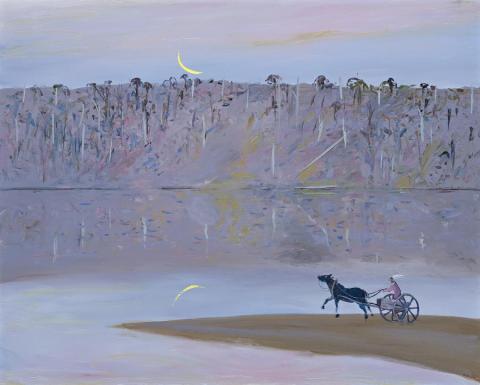JINKER ON THE SANDBANK, SHOALHAVEN, 1986
Arthur Boyd
oil on canvas
122.0 x 152.0 cm
signed lower right: Arthur Boyd
Wagner Gallery, Sydney
Private collection, Sydney
Arthur Boyd, Wagner Galleries, New York, 1987
...The river is, of course, the most compelling image in many of these paintings from this period. Boyd has captured it in all its moods, quiet as floods begin to recede; ugly brown as it swells with water; dark, calm and green in summer when the land is parched; glowing pink at sunset.'1
After almost two decades abroad, in 1974 Arthur Boyd settled on the banks of the Shoalhaven River where once again the magic of the dour, untamed Australian landscape became the impetus for his art. Soul-piercing in its beauty, the region offered infinite potential as a subject - 'the variation in the area with its great deep tones and high keys'2 bearing strong affinities with music. Invariably though, the artist's love for the region was infused with a deep respect and latent fear - for the Shoalhaven was not always kind. In 1975, heavy rains transformed the placid flowing river into a great swollen torrent that engulfed everything in its path: as Boyd observed at the time,'...the river moans and groans in a muted way, and great chunks of what was upstream comes down- dead cattle with their legs sticking up, logs and roof tops. Once a whole house came down the river.'3 When the waters finally subsided, all that remained was an earthly silence and the land strewn with death and debris.
Indelibly influenced by these events which left the artist and his family marooned, Boyd subsequently embarked upon a series of landscapes so redolent with pending disaster '...it is as if Nature is holding its breath.'4 Drawing upon the motif of the horse and jinker first employed in his poetic tribute to his mother, Potter's Wife, Horse and Trap (Rosebud) 1969-70, the artist thus explored through various compositions the theme of the lone rider venturing across a watery landscape presided over by the menacing black crows of death. In Black Horse 1975 for example, the horse stumbles uncertainly towards the water, while in Jinker on Sandbank, 1976-77, fear has transformed the rider into a hare, and in Figure Driving Beneath Pulpit Rock, 1976, the horse has been completely replaced by a pair of swans which imbue the work with a surreal, almost disquieting sense of calm.
Strong and lyrical, the present Jinker on a Sandbank, Shoalhaven illustrates well the positive, dynamic spirit that distinguishes Boyd's later treatment of the subject from his earlier investigations. The horse and rider now charge at full gallop towards the water with obvious determination, while in the distance, the warm glow of the pale pink evening sky and crescent moon suggest good times ahead. With the mirror-like expanse of water and colourful afterglow paying homage to his artistic predecessors such as Von Guerard and Piguenit, indeed the work is a poignant reminder of how Boyd, comfortable once more with the vast open spaces of the Australian landscape, ultimately did tame his wilderness '...what was unfamiliar became familiar, what was menacing became friendly, what was awesome became intimate.'5
1. Boyd cited in McGrath, S., The Artist and the Shoalhaven, Bay Books, Sydney, 1982, p. 220
2. Boyd cited in Pearce, B., Arthur Boyd Retrospective, Art Gallery of New South Wales, Sydney, 1993, pp. 26-27
3. Boyd cited in McGrath, op.cit., p. 58
4. Hoff, U., The Art of Arthur Boyd, Andre Deutsch, London, 1986, p. 73
5. McGrath, op.cit., p. 79
VERONICA ANGELATOS
